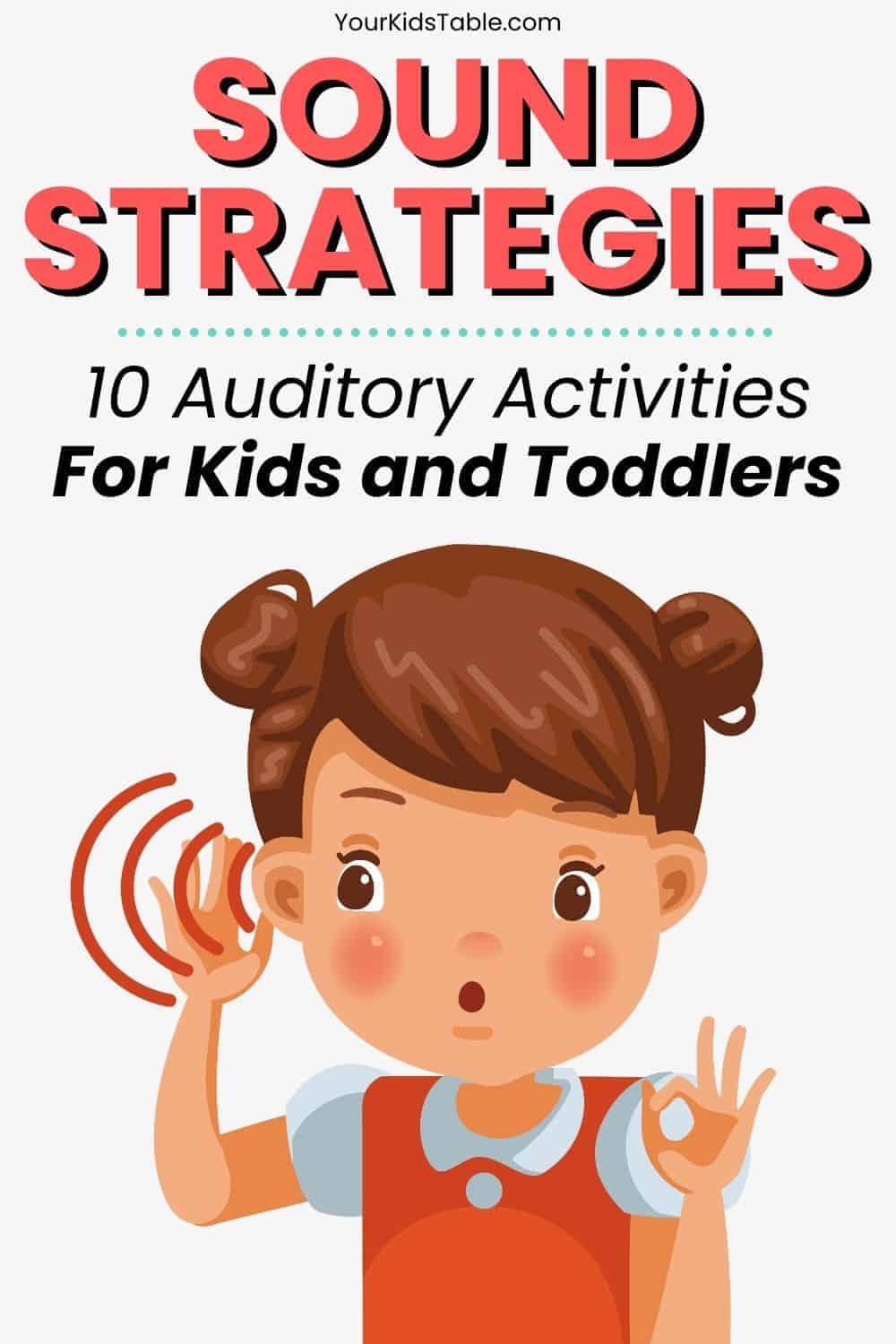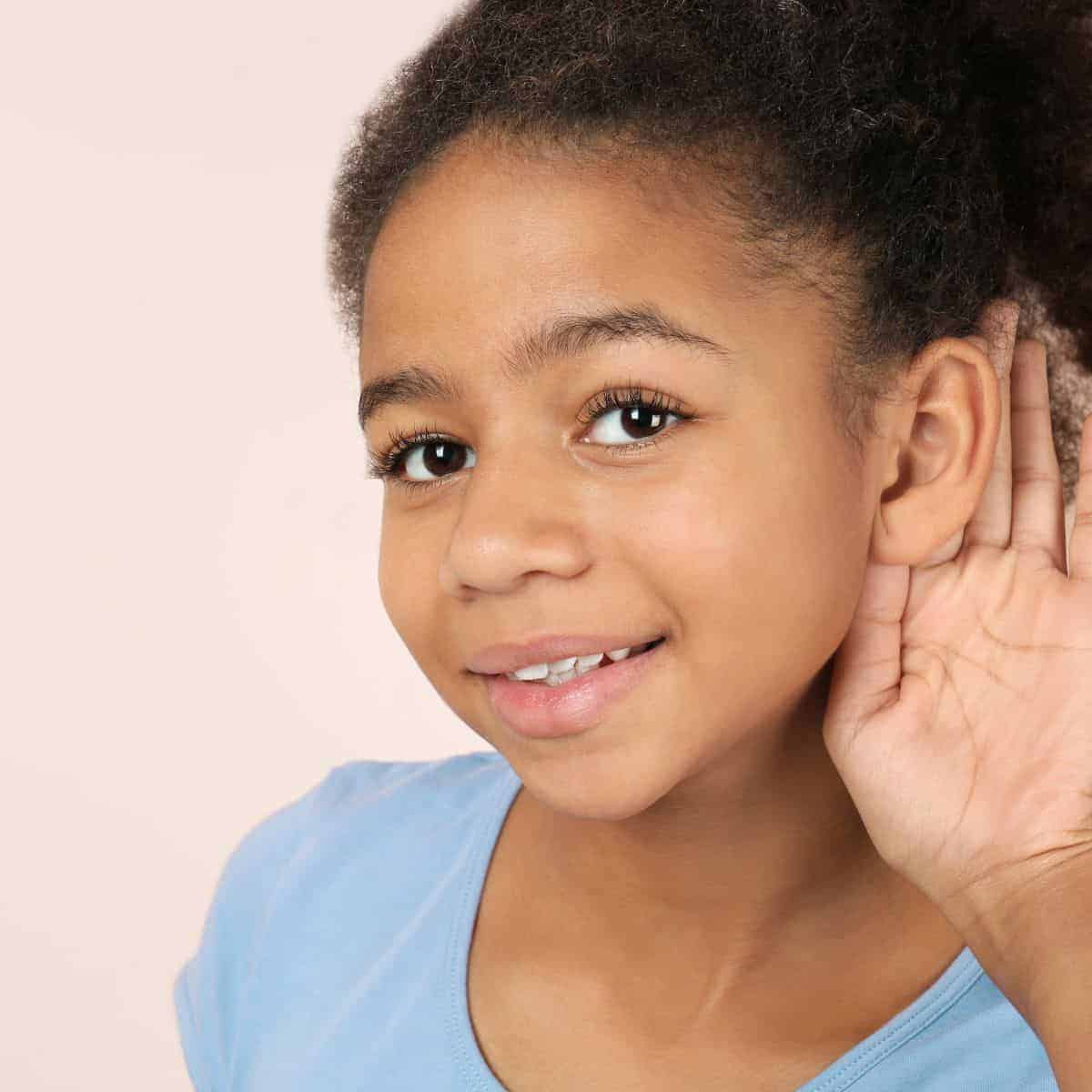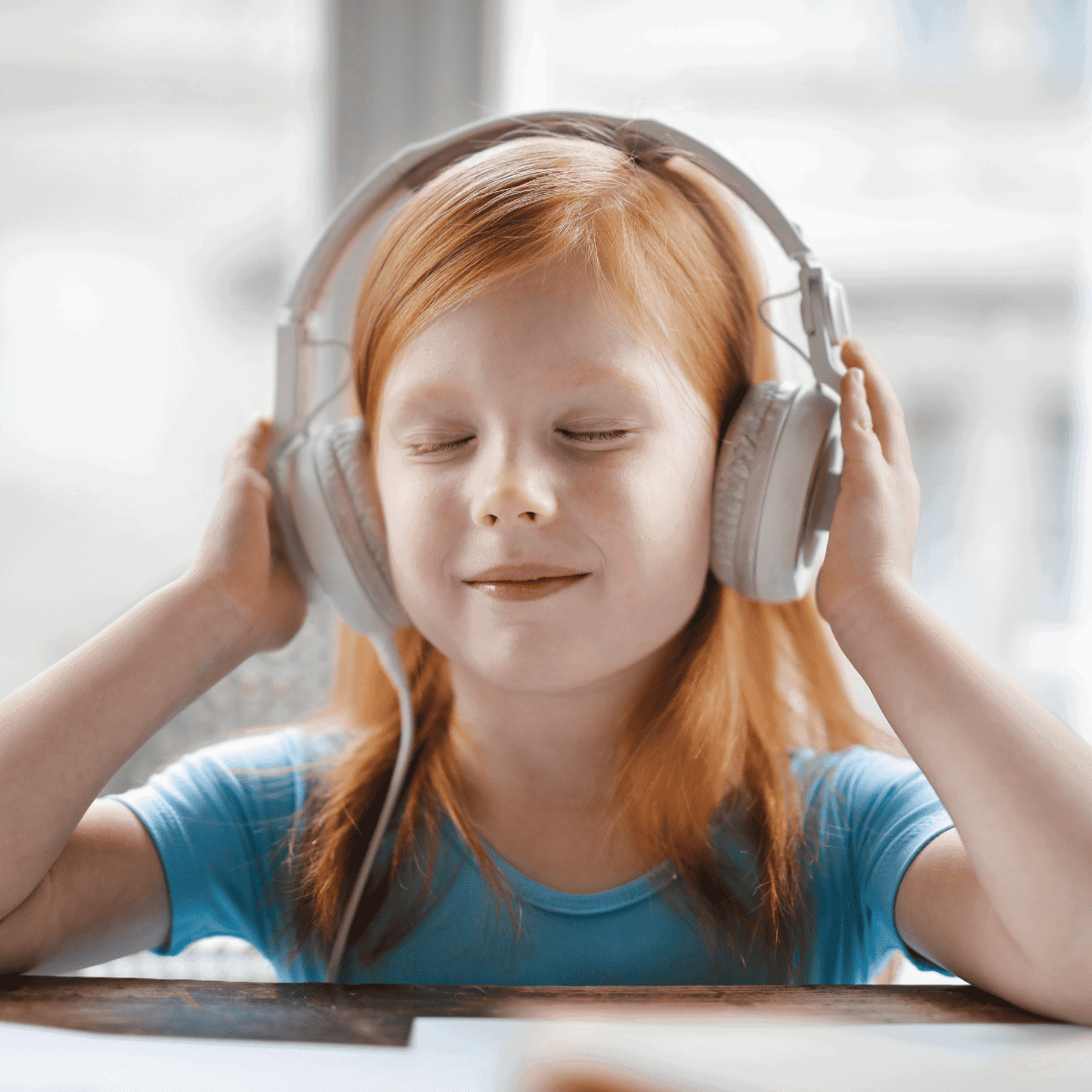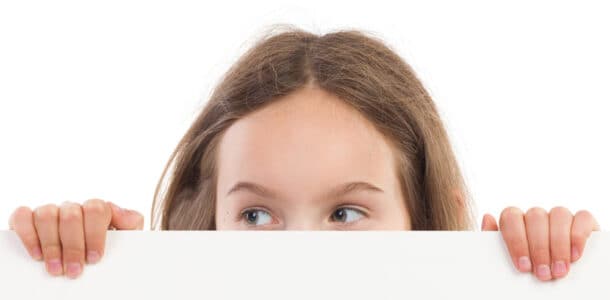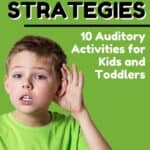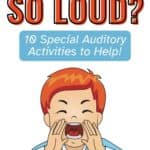Auditory sensory activities are perfect for helping kids overcome auditory processing disorders, auditory seeking and auditory sensitivities. Try these 10 activities to help with auditory sensory processing.
“She is so loud! She yells and talks over me constantly.”
“He has a meltdown every time he hears the hand dryer in a public restroom.”
“I told him to brush his teeth and put on pajamas, and it was like the words went in one ear and out the other!”
Listening skills, volume control, and other behavior related to our sense of hearing are common complaints from parents of sensory kids.
The ability to process all of the sounds around us is a collaboration between our ears, our brains, and auditory sensory information which all make up our sense of hearing.
Hearing is an important piece of our 8 senses that make up sensory processing.
That’s why it’s important to understand the auditory system, how it works, and signs of auditory processing difficulties, and auditory activities to help auditory seekers, avoiders, and kids with low registration of this sense.
That means whether your child can’t get enough loud music, or runs and hides at the first sound of the vacuum cleaner, these activities are for you.
But first, let’s talk about how it all works.
The Auditory System (Our Sense of Hearing)
The auditory system processes how we hear and understand sounds within our environment.
There are both peripheral and central structures that make up our sense of hearing, and both send environmental sensory input in the form of vibration and sound waves to be processed by the auditory cortex of our brains.
Like all other areas of sensory processing, our sense of hearing is connected to other senses.
When we hear a noise and process what it means, our eyes, head, and body respond to the sound, either following it (like hearing someone call our name) or moving away (like from a dangerous barking dog).
Hearing is an important developmental factor from early infancy and throughout our lives. When we’re born, it’s one of our keenest senses, allowing us to recognize our mother’s voice, and sounds around us.
It can help us feel calm or alerted, depending on what we hear and how our brain processes this information.
Our ears are also deeply connected to balance, which is controlled by the vestibular sense.
When we are first born and our sense of vision is very poor, our auditory processing is a huge part of how we interact with the world around us, and it continues to grow as we do.
When there is difficulty somewhere in the process of hearing a sound, whether a child is sensitive to noise, misses some sounds, or seeks it out because they can’t get enough, it’s likely to impact other areas of their development!
Auditory Seeking Vs. Auditory Avoiding
Just like any of our other senses, sometimes the brain overprocesses or craves more of a particular type of input.
With sound sense, you will see toddlers and kids (and adults) sometimes have great challenges with being sensitive to various sounds, while other kids may LOVE and seek out loud noises.
Of course the latter can be very difficult for anyone that’s in the same environment as the auditory seeker, because they too are getting all of the auditory input.
An auditory seeker is actually desensitized, or under processing the sounds around them, and as a result, seeks out more sound through loud, repetitive, or chaotic noises.
Signs of Auditory Seeking
You will know a child is seeking auditory input if you see (or hear) them:
- Bang on objects in their environment often
- Gravitate towards play with musical instruments, playing them very loudly
- Prefers to listen to music often, possibly at a loud volume
- Likes to sing or hum
- Gets very close to speakers, radio, tv, or phone
- Makes silly or inappropriate sounds frequently
- Mimics sounds of objects like beeping, or copies the speech of others
- Talks to self constantly, or speaks very loudly, even yelling
Signs of Auditory Avoiding and Sensitivities
Over-responsiveness to the auditory system, also known as a sensory sensitivity, can cause a toddler or child to overreact to auditory sensations that their ears hear and their brain processes.
Common triggers for kids are unexpected blaring fire trucks, hand dryers in the bathroom, blenders, hand dryers, etc. Basically any loud sounds in the environment.
Extreme hypersensitivity to sound, or over-responsiveness, is often diagnosed as misophonia or hyperacusis.
Misophonia is a disorder that’s characterized by a difficulty tolerating specific types of noises, and may cause adverse physical reactions, such as becoming nauseated by the sound of chewing or slurping.
These sounds typically aren’t loud, and are often associated with eating. To the individual with misophonia, hearing someone chew potato chips next to them might as well be fingernails being dragged down a chalkboard.
Hyperacusis, on the other hand, is characterized by a sensitivity to sounds.
This means that even gentle sounds, like an overhead fan can be deafening or physically painful to a child. In this case the brain is definitely overprocessing the sound input.
A child’s response to this type of auditory sensitivity may look like:
- Startling easily and acutely reacting to unexpected sounds like thunder, fireworks, hand dryers, toilets flushing, or dogs barking
- Humming to distract oneself from background noise, or makes unusual noises to seemingly self-soothe.
- Dislikes noisy places with crowds of people, like cafeterias, sporting events, or public shopping centers.
- Shushing others or asking others to stop talking, no matter their volume.
- Overly sensitive to speakers in cars, televisions, etc.
- Crying or whining in response to typical sounds like music, talking, or television noise
- Holding hands over ears, or uses fingers and objects to block sounds
- Sensitivity to certain sounds such as lawnmowers, laundry machines, hum of the refrigerator, even quiet noises like fluorescent lights buzzing or distant fans
- Easily distracted by sounds and background noise in the classroom or public
- Complaining of ringing ears, or residual noise after leaving a noisy environment
4 Auditory Processing Difficulties
Besides overprocessing and underprocessing, the auditory system can lose track of or tangle up sounds making it hard for the brain to interpret what it’s hearing or how to in turn verbally respond.
This is referred to as auditory processing difficulties.
There are 4 types of auditory sensory processing difficulties, here are what they are:
1.Decoding: The auditory system doesn’t understand the words that are spoken. They hear the sounds, but their brains do not process them as words. This is related to receptive language, which is our ability to understand what’s spoken.
2.Integration: This challenge is evident when the brain struggles to process multiple types of input at one time. For instance, if you’re in a conversation while your kids are asking you 100 questions, you can lose your focus, and not remember what you were saying.
3.Prosodic: Prosodic refers to people who have trouble with tone, inflection, and implied meaning. A question and exclamation are processed identically in their brains. Many people with Autism Spectrum Disorder (ASD) or social-emotional difficulties struggle in this area.
4.Organizational: This is also called output, and is often characterized by not recalling information in a specific order or having difficulty with noisy situations. This can be similar to integration, but specifically has to do with recalling specific orders of information.
And, sometimes difficulties with auditory processing may be generally related to low registration, which is when the sound input is not registered. Some signs of auditory low registration are:
- Seeming to be unaware of sounds in their environment
- Poor listening or direction-following skills
- “Zoning out” and poor receptive language (ability to understand and respond to direction)
- Difficulty tracking sounds, like knowing where to look to find a teacher, for example
Benefits of Auditory Input
While there are lots of different challenges related to the auditory sense, auditory sensory processing can greatly improve with the right strategies or sensory activities.
Specifically, auditory sensory activities can help kids with their:
- Cognitive development and learning
- Speech and language skills
- Emotional regulation
- Social and play skills
We notice with our sensory kids that often it’s not one sensory area being challenged, and there is no hard and fast rule for whether a child is ALWAYS sensory seeking or ALWAYS sensory avoidant. It often varies.
In our RISE with Sensory program, we’ve had multiple parents report “My child constantly talks too loudly, screams, and interrupts, but when others talk, they cover their ears.”
This is a great example of these fluctuating sensory sensitivities.
Knowing what to look for in your child’s behavior is key to addressing their sensory sensitivities with the right auditory input.
This means that if your child is sensitive to the sound of the hand dryer in the public restroom, but screams and talks over you constantly, each behavior can improve, but only when you address what’s going on in each scenario.
Since the fear of the blowdryer is a result of overprocessing the noise, their auditory processing skills can strengthen with specific activities related to desensitizing that sound.
And for the yelling and talking loudly, strategies to help the underprocessing of the auditory input can improve this skill.
We will break the activities down in the following sections so that you can easily pick which one’s will help meet your child’s sensory needs.
But to get a clearer idea of ALL your child’s sensory needs across the 8 senses, I highly recommend our free sensory workshop, you’ll learn deeper strategies for helping your child with their sensory needs.
Auditory Sensory Activities
Great news, auditory sensory activities are simple for parents to use at home or therapists to incorporate into their treatment sessions for any child who needs to work on auditory processing.
These activities are perfect for sensory seekers, and some can be used for auditory avoiders, and may help decrease some of their sensitivity to the sounds around them.
Auditory Sensory Activities for Seekers, Avoiders, and Older Kids
1.Listen to Audiobooks, Yoto Story Players, or Toniboxes
-
- For sensory seekers: choose stories with upbeat and vibrant music and sounds, sound effects, and creative voice acting
- For sensory sensitive: choose calming, non-lyrical music, meditations, or soothing stories
- For older kids and those working on cognition and auditory processing skills, have them recite story themes, answer questions, etc.
- Add a motor skills component by acting out the stories you hear
2. Clapping, stomping, or moving body to music in responsive songs like “hokey pokey,” “freeze,” “macarena,” “head, shoulders, knees and toes” or action songs like wheels on the bus.
-
- For seekers: Have kids be barefoot, clap hard, make big, exaggerated movements, play in an echoey room, with groups of kids for increased volume
- For avoiders: wear gloves for clapping, wear noise canceling headphones, small groups, in open space like outdoors
- For older kids: Try line dancing, dance classes, or gymnastics where child completes routines based on music
3. Musical Instrument play, including trying out various genres and creating rhythmic patterns
-
- For seekers: Stick to loud musical instruments, using wood, metal, or plastic mallets, amplifiers, in an echoey room like a bathroom, stairwell, or room without carpet
- For avoiders: use mutes if available, ear protection, rubber mallets (as opposed to wood or metal), a room with foam sound absorption
- For older kids: Try repeating musical patterns or playing “mirror” where one person plays a melody and the next person tries to copy it
4. Experiment with dropping various items onto different textures or guessing the item. For example, a pencil falling on tile floor vs. carpet, or blindfolding a child and dropping a light item and having them guess what fell like “egg shell” vs. “ping pong ball”
-
- Try dropping from different heights for increased sound, and have your child experiment with standing closer or further away from the sound as needed
5. Make a can and string telephone game
-
- For seekers: Use louder volume, singing songs, or shouting cheers through the “phone” and stand closer together with a shorter line
- For avoiders: Use calmer, quieter voices, and stand farther apart
6. Use Walkie-Talkies in various locations
-
- For seekers: Allow them to have the volume out loud
-
- For avoiders: Show them how to turn the volume down and intentionally say less across the walkie-talkies.
- For older kids: Spell words or say rhymes that the other person has to repeat
7. Play with environmental sounds exploration and have child locate different sounds like a firetruck, speaker, etc in various environments like:
-
- Nature sounds
- Urban sounds
- Household sounds
8. Play “I went on a picnic” repeat games where the child has to listen to and repeat back an increasing series of objects
9. Play listening and processing games like BINGO and Simon Says.
10. Volume play whisper/yelling and the use of microphones, speakers, etc.
How to Use Auditory Sensory Activities With Your Child
While the list above is a great starting point for doing hearing-based sensory activities with your child, they have to actually want to do them, so here are some strategies to get them excited about it.
Try tailoring the activities to your child’s preference and abilities so they are more likely to want to engage. For example, if you have an animal-obsessed little one, maybe walk around a farm or nature open space and listen to the animal sounds for your environmental exploration.
Or take a family outing to a symphony or local concert.
Kids who have sensitivities to sound are likely going to need a slow and steady approach to building up their tolerance to sound and volume. So work on gradual exposure that works toward slow desensitization.
This means allowing the child to lead and NEVER forcing an activity, which is true for all sensory activities.
Try incorporating these listening auditory activities into daily routines so that your child get practice with these skills in the repetition of everyday activities.
For instance, your auditory seeking child could listen to music every time they brush their teeth, to help them meet their needs as part of their routine.
Strategies For Auditory Sensitivities
When a child is having auditory processing difficulties, whether they’re auditory seeking, or sensitive to loud noises the following strategies might help a sensory sensitive kiddo:
- Consider using foam earplugs, soft earbuds or noise canceling headphones to dull sounds, especially in noisy environments
- Keep music soft, calm, and rhythmic
- Add soft material like felt or cut tennis balls to the bottoms of desk chairs and desks
- Use rugs to decrease echo sounds on hard floor
- Go to public places like parks, restaurants and malls during low traffic hours
- Adding in support for another sensory system like visual schedules or visual prompts
- Use a physical prompt, object, or song to indicate a transition like “clean up” or “time to go” song as a cue
- Slow down speech when giving directions, or add visual components and have the child repeat instructions back
- Seat child away from hallways, windows, or busy areas at school, and give a quiet room in the house for a space to retreat, like a sensory room.
- Use gentle tones or a whisper voice
Want More Sensory Activity Ideas to do with Your Kid?
There are so many exciting and helpful sensory activities for kids, but many parents don’t know them. Grab our printable cheat sheet with 25 of our favorites.
There are some other surprises in our Sensory Essentials Printable pack like a complete customizable template to make your child their own sensory diet. Grab it here, and we’ll send it right to your inbox.
Learn More About The Senses
The Most Awesome Smell Sensory Activities You Can Find!
The Secrets of the Mighty Tactile Sense Revealed
Powerful Proprioceptive ActivitiesThat Calm, Focus, & Alert
Interoception: The Secret Sense That Controls Appetite, Toileting, and Emotions
Alisha Grogan is a licensed occupational therapist and founder of Your Kid’s Table. She has over 19 years experience with expertise in sensory processing and feeding development in babies, toddlers, and children. Alisha also has 3 boys of her own at home. Learn more about her here.
